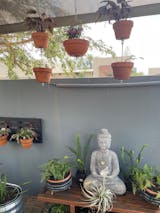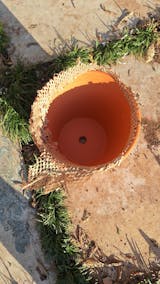
Growing daffodils in South Africa
Ah, the daffodil, nature's little burst of sunshine! These cheerful trumpeters of spring are like the garden's way of saying, "Hey there winter, pack your bags, it's time for you to go!" Daffodils know what they want, and if you give it to them, you will be growing them with ease. The mass of blooming colour they bring is perfect for the time of year when everything feels cold and gloomy.
Daffodils grow from true bulbs native to the fields and woods of southern Europe. They evoke images of the coming of warmer days in the English countryside, but despite their cool climate beginnings, the daffodil has naturalised extraordinarily well around the world.
Do daffodils grow in South Africa?
Now, if you're thinking of planting these floral superstars in South Africa, fear not! Daffodils aren't just for the English countryside; they're ready to strut their stuff in your garden too, provided you give them the right care. What’s more is they can be left in the ground during dormancy and will spring back to life each year. Extremely frost-hardy, there are very few places in South Africa that they won’t flourish. All they need is a little tender loving care.
Which is the best month to plant daffodil bulbs?
Picking the right time to plant these botanical beauties is like setting up a blind date - you want the soil to be cool, but not frostbitten. Aim for the end of April until May, when the soil has cooled down from its summer fling. You can also plant them as soon as the end of March, but just be patient as you wait for them to sprout. It’s the cold soil that activates their growth.
Where do daffodils grow best?
Daffodils grow best in dappled light. Give them a well-draining spot to call home, preferably under the dappled shade of a tree, or in a cozy container. They will also bring joy to the mixed perennial border.
How to grow daffodils
When it's time to plant, dig in and get your hands dirty. Show that soil who's boss! Daffodils will adapt to most well-drained garden soils but it is advisable to dig the beds over to a depth of at least 20cm. Add loads of compost and an optional dressing of bonemeal to ensure they get all the nutrients they need. Dogs like bonemeal as much as your daffs will, so beware that your little angel may be enticed to dig. Remember, if the ground is too cold for you to sit on, it's just right for daffodils. So get planting, and maybe do a little dance while you're at it - after all, gardening is just nature's way of telling you to shake your petals! It is vital that you water deeply every 3-4 days from the time they are planted until they have completely died down in early summer. Water for about 10 minutes each time, provided you aren’t in a winter rainfall region. Be sure to keep the soil constantly moist but not soggy as you don’t want the bulbs to rot. You can plant Muscari and Ipheion in the border surrounding your daffs for a complimentary display.
How to care for daffodils
Mulching the soil will keep their roots cool, protect the flowering plant from cold, drying winds, and will also help to conserve moisture.
Once you see the shoots poking out, give your daffs a handful of Hadeco Bulb Food and don’t forget to give them food once they’ve finished flowering. This will help the bulbs bulk up and create their flowers for the next season.
If you’re going to be dividing your daffs, only do so once the foliage has died back. In the right conditions, and left to their own devices, they can bloom for 50 years or more. The ‘mother’ bulb will flower for six to eight years, but her ‘daughters’ - also known as bulblets, are clones and will continue to flower as successive generations, indefinitely. So keep your daffs blooming for generation after generation, and don’t disturb them too much…
What does a daffodil symbolise?
A daffodil symbolises rebirth and new beginnings. It's one of the first flowers to bloom at the end of winter, announcing the beginning of spring.
Narcissus may be a symbol of unrequited love and there is a story behind their name. A nymph named Echo fell in love with Narcissus, a Greek hunter who was known for his remarkable beauty. He rejected Echo’s affections and was ultimately unmoved by the affections of others. This caused him to face divine retribution for his indifference. Nemesis, the Greek goddess of vengeance, orchestrated his downfall by entangling him in the trap of self-love. Entranced by his own reflection in a pool of water, Narcissus experienced the agony of unreciprocated affection, ultimately withering away. Thus, he metamorphosed into the flower that now bears his name, forever immortalising his tale of love and loss.
What is special about daffodils?
- Daffodils are the official 10th wedding anniversary flower.
- In Chinese tradition, if they are ‘forced’ to bloom for the Chinese New Year, it will bring luck to the whole household.
- In Japanese culture, the daffodil represents joy, while in France, it serves as a symbol of hope.
- According to legend, daffodils are linked with joyfulness. When offered in a bouquet, they symbolise the gift of happiness. Conversely, if presented as a single bloom, it's believed to signify misfortune.
- Under optimal conditions, a thriving daffodil field can flourish for a remarkable span of up to 50 years. These resilient flowers thrive in locations boasting excellent drainage and ample sunlight. They particularly favour areas where the grass can grow undisturbed, making hillsides and open spaces prime choices for daffodil cultivation.
Daffodils as cut flowers
When cutting for the vase, make them the star of the show. Keep them solo as the latex in their stems will leach out into the water and shorten the life of other flowers.
On the other hand, if you soak the daffodils alone for 12 hours before, they can be safely incorporated with other flowers.
So there you have it, folks - the lowdown on daffodils. Plant them, pamper them, and watch them dazzle your garden with their sunny disposition. Who knows, maybe they'll even teach you a thing or two about blooming where you are planted!
Disclaimer: Daffodils are toxic and should not be consumed. Keep away from children and pets.


September
20 - 21,
2025





Leave a comment